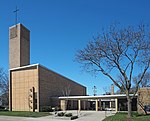Cooper, Minneapolis
AC with 0 elementsMinnesota populated places on the Mississippi RiverNeighborhoods in Minneapolis

The Cooper neighborhood (part of the larger Longfellow community) resides along the west shore of the Mississippi River in south Minneapolis. It is bound by 34th St. E. on the south, 38th Ave. S. on the west, 27th St. E. on the north, and the river gorge to the east. Bordering neighborhoods are Seward to the north, Longfellow to the west, and Howe to the south. St. Paul's Merriam Park neighborhood is just across the Mississippi River to the east. Cooper was named after the 19th-century author James Fenimore Cooper, best known for writing The Last of the Mohicans (1832).
Excerpt from the Wikipedia article Cooper, Minneapolis (License: CC BY-SA 3.0, Authors, Images).Cooper, Minneapolis
43rd Avenue South, Minneapolis
Geographical coordinates (GPS) Address Nearby Places Show on map
Geographical coordinates (GPS)
| Latitude | Longitude |
|---|---|
| N 44.94451 ° | E -93.2117 ° |
Address
43rd Avenue South 3212
55406 Minneapolis
Minnesota, United States
Open on Google Maps










